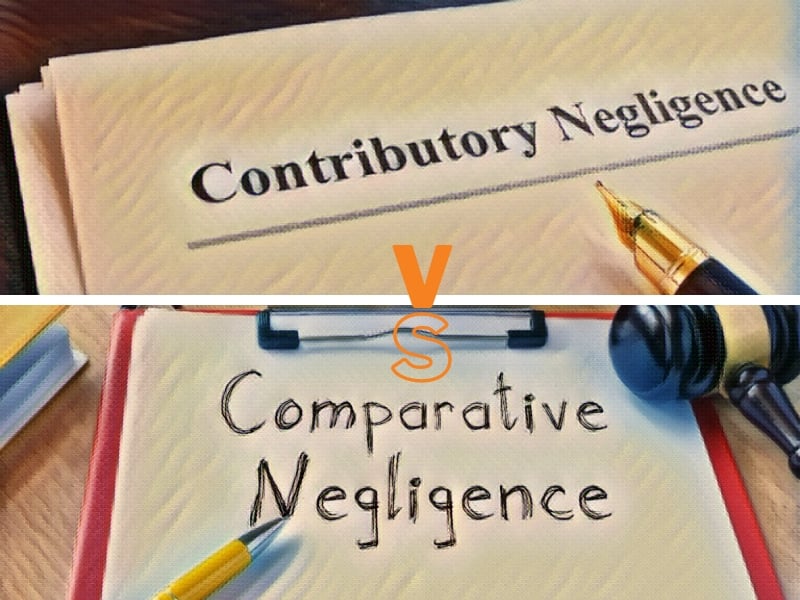
The main difference between contributory negligence vs comparative negligence comes down to how your percentage of liability impacts your possible recovery. Contributory negligence completely disqualifies you from recovering damages if you were partly liable for the accident, while comparative negligence allows you to recover damages for a portion of your injuries, even if you were partly liable. The legal doctrine of contributory negligence stemmed from common law, while comparative negligence is an enactment of the legislative authority in states that abandoned the outdated common law version.
What Is Contributory Negligence Versus Comparative Negligence?
Determining liability in personal injury accidents can be difficult. States use the legal doctrines of contributory negligence and comparative negligence to assign liability between the different parties involved in an accident. Illinois operates on a modified comparative negligence model.
Understanding the difference between contributory negligence and comparative negligence can help you avoid confusion during the civil claims process. These legal doctrines are also known as “fault systems,” so, they may sometimes be referred to as “comparative fault” or “contributory fault.” These terms still refer to the same negligence systems.
Contributory Negligence
What is contributory negligence? That is the question you might ask if you got injured in an accident in a jurisdiction that adopts the contributory negligence model. This negligence system allows only a plaintiff who is 100% free from liability to obtain compensation from the defendant. Simply put, you cannot receive compensation if you were partly to blame for your injuries. This consideration applies even if your share of liability is only 1%.
Example: Let us assume Driver A is speeding down a busy street. Driver B takes a left turn in front of Driver A, hitting Driver’s A vehicle. The jury finds Driver B is 99% liable and Driver A is 1% liable. Under the contributory negligence system, Driver A cannot recover damages from Driver B, as Driver A was liable when he or she failed to drive at a reasonable and careful speed.
Contributory negligence arose from an English case where the plaintiff was denied compensation for his injuries on the grounds that he had directly caused his injuries by failing to exercise common and ordinary caution. The U.S. adopted this legal theory in 1824.
Comparative Negligence
If you were partly to blame for your injuries, you might wonder, “does partial liability prevent financial recovery?” If you are in a jurisdiction that operates under comparative negligence, partial liability will not bar you from recovering monetary compensation for your injuries.
The comparative negligence rule reduces your recoverable damages in a personal injury suit by your share of fault. If a jury determines that you are 30% liable for your injuries, your total recoverable damages will be slashed by 30%.
Comparative negligence has two different approaches:
Pure Comparative Negligence
Under pure comparative negligence, you can still recover compensation even when your share of fault surpasses that of the defendant. A jury determines the value of your injury claim and then deducts your share of fault from your total recoverable damages.
Example: Let’s assume a jury determines that you are 70% liable for the accident and values your injury claim at $70,000. In this case, you will recover $21,000 (representing $70,000 less 70% of your share of the fault).
Modified Comparative Negligence
The modified comparative negligence further falls into two different approaches. They include.
- The 51% Approach: This approach allows the plaintiff to recover damages provided the plaintiff’s share of fault does not exceed 50%. For instance, if the jury determines you are 50% liable and your total recoverable damages are $70,000, you can still recover $35,000. You will recover nothing if the jury finds you are 51% at fault. You will recover $49,000 if you are 30% liable. Illinois follows this approach.
- The 50% Approach: This approach allows the plaintiff to recover only if his or her share of fault is below 50%. You will recover nothing if you are 50% liable, and this 50% rule applies in your case. Arkansas, Georgia, and Colorado are some states that operate under the modified comparative negligence doctrine with a 50% bar.
Proving Fault in a Personal Injury Claim
Proving fault in a personal injury claim involves demonstrating the four specific elements of negligence. This demonstration involves showing that:
- The liable party had a legal duty to prevent or avoid harming you;
- The liable party violated that duty;
- The violation directly caused you harm; and
- You suffered losses as a result of the harm.
You will need adequate evidence to prove each of the above elements. In a car accident-related personal injury claim, pictures and videos of the accident scene can show how the accident happened and who was at fault. Video and photographic evidence, along with witness statements, can help strengthen your injury claim. They can also help an accident reconstruction team recreate the accident to identify the liable party if necessary.
A police report can provide an impartial third-party account of the accident. It can also specify which party is liable for the accident according to the on-site investigation and the responding officer’s perspective.
An expert witness testimony may be required to prove fault in a personal injury claim. This is especially true in medical malpractice-related personal injury claims. An expert witness can demonstrate how your treating doctor acted negligently and which steps the doctor should have taken to protect you from unnecessary injuries.
Establishing a Victim’s Negligence
The defendant and the insurance company may present sufficient evidence to prove a victim’s negligence. They might, for instance, demonstrate that you failed to act reasonably carefully and that failure caused the accident and your injuries.
An aggressive personal injury attorney with a record of fighting for victims of negligence can help you disprove the defendant’s claims that you were partly at fault for your injuries. The attorney can compile enough evidence and work with expert witnesses to help you recover maximum compensation for your injuries.

